

Researcher Amy McNally spent two weeks in Yanco, Australia to participate in the three week Soil Moisture Active Passive Experiment-4 (SMAPEx-4) field campaign in May. The field campaign measures soil moisture and related data using ground and airborne instruments. The data is used to validate actual data and algorithms from the SMAP satellite. In the following Q&A, McNally shares her experience on the SMAPEx-4 ground validation team and her first impressions of Australia.

McNally and her team pack up at the end of a long day of taking ground measurements (photographer Amy McNally)
NASA: What do you do at NASA’s Goddard Space Flight Center for your day job?
McNally: I am a Post-doctoral researcher in the hydrologic sciences lab, where I am customizing the NASA Land Information System for food and water security applications in Africa and the Middle East. This work supports the US Agency for International Development (USAID) and the Famine Early Warning Systems Network (FEWS NET). Day-to-day, I run hydrologic models that use remotely sensed, satellite inputs (rainfall, vegetation, and soil moisture) and use the outputs to answer USAID’s questions about, for example, the current water crises in western Yemen and southern Botswana.
What are your tasks in the SMAPEx-4 field campaign?
Starting at six every morning, we are measuring near-surface soil moisture and recording the land use/land cover type (mostly, crops and pastures), vegetation height, and the presence/absence of irrigation. We sample every 250 meters (0.15 miles), which adds up to walking about 9 kilometers (5.6 miles) a day over 5 hours.
How does your fieldwork compare and contrast to your job back at Goddard?
The work is very different! This fieldwork is physical labor – 9 km of walking is a lot for people who normally sit at a desk. However, it is still important to pay attention to details, stay organized, be efficient with time, troubleshoot problems with equipment (including the mini-computer/data logger and software) and help out other members of the team.
What do you enjoy about being part of SMAPEx-4?
First, we get to meet other scientists from all over the world who are interested in remote sensing hydrology. My sampling team has people from South Korea, China, Iran, Panama and Australia. Our similar research experiences are a good starting point for conversations about all of our differences – in research (ranging from algorithm development to downscaling to applications) and culture (food, language and customs).
Second, it’s also great to be walking in the outdoors for hours. And of course, just being in Australia! We see so many different types of birds (emus!), as well as kangaroos, foxes and lots of sheep. But nothing tops the koalas!
How has this experience changed your perspective on how you understand SMAP data?
This was a great opportunity to learn more about the SMAP mission as well as other current microwave satellites (Soil Moisture and Ocean Salinity and Aquarius). Since I work on SMAP applications, it was interesting to learn more about the airborne active and passive sensors, and the design of the field sampling strategy that will be used for calibration/validation activities. I have greater appreciation for all the hard work that so many people are doing to make the SMAP mission a success.
For more updates from the field, visit the SMAPEx-4 blog.
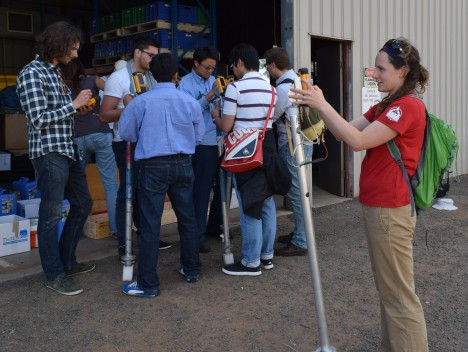
Amy NcNally (Front) of NASA, Alex White (Far left) of USDA and other members learn how to operate their field equipment. (Photographer Lynn McKee)
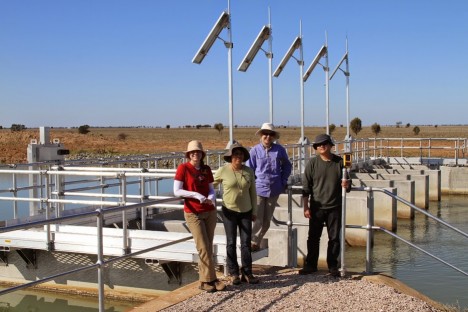
McNally with her ground validation team. Photographed from left to right: Amy McNally, Fuqin Li, Sabah Sabaghy, Seokhyeon Kim (photographer/captain Alan Marks)
It’s 3 a.m. in Yanco, Australia, a remote region located 380 miles (612 kilometers) west of Sydney. While most people are still in bed, a small team of scientists prepares for takeoff in an aircraft that will gather data about the soil below. The early-risers are investigating the amount of moisture in the top 2 inches (5 centimeters) of the soil — a measurement similar to those made by NASA’s Soil Moisture Active Passive (SMAP) observatory orbiting 426 miles (685 kilometers) above in space.
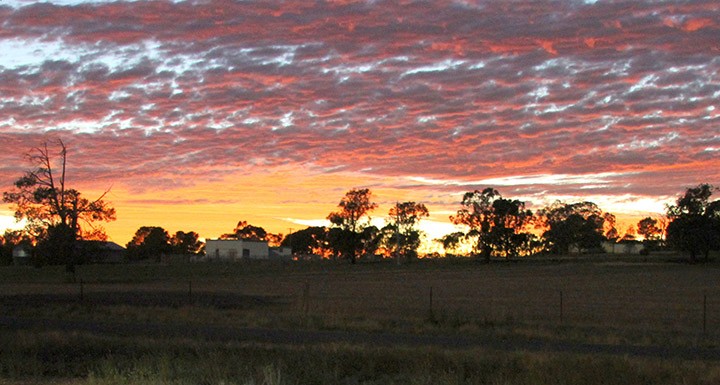
Photo by Amy McNally.
Four hours later at daybreak, three more teams of scientists will head out on foot with specialized tools to measure soil moisture, vegetation coverage and surface roughness.
In total, around 40 scientists are studying the Australian soil as part of the Soil Moisture Active Passive Experiments-4 (SMAPEx-4) field campaign from the ground and air — the first major soil moisture field campaign conducted since SMAP launched Jan. 31, 2015. The three-week study, conducted from May 2 to May 22, is designed to validate soil moisture measurements from SMAP.
SMAP provides global soil moisture measurements every two to three days. The global maps will improve weather prediction, enhance flood forecasting and inform agricultural practices, including during droughts.
“Our scientists are taking the time to validate the SMAP products,” said Peggy O’Neill, SMAP deputy project scientist at NASA’s Goddard Space Flight Center in Greenbelt, Maryland. “This field campaign will help provide proof that our hard work is paying off.”
This field campaign is the fourth in a series of five SMAPEx campaigns in the region. Jeff Walker, the SMAPEx-4 project lead and professor at Monash University in Melbourne, Australia, says the previous campaigns were for algorithm development using aircraft instruments that simulated SMAP readings, but this campaign is for validation of actual SMAP algorithms and products.
“The aircraft campaign is the best way to directly test the algorithm for SMAP’s core soil moisture product at a spatial resolution of 9 kilometers,” said Simon Yueh, SMAP’s project scientist at the Jet Propulsion Laboratory in Pasadena, California. “The campaign’s three week duration will allow the observations of some precipitation and dry down cycles to validate the SMAP products over a variety of conditions.”
The SMAP satellite is estimated to pass over the Yanco region at approximately 6 a.m. local time and provide three high-resolution readings per week that the SMAPEx scientists can use. SMAP carries an active radar and passive radiometer. The active microwave radar sends a signal to the ground and measures the reflected radar pulse sent back to SMAP—a measurement called backscatter. SMAP’s passive radiometer measures brightness temperatures, a measurement of temperature based on how much microwave radiation is naturally coming from the ground. These SMAP measurements are converted to soil moisture observations.
The aircraft, also carrying a radar and radiometer, provides microwave backscatter and brightness temperature observations at high resolution to help verify SMAP’s products. The aircraft flies for about six hours during a SMAP overpass and mimics SMAP’s readings in terms of wavelength, viewing angle and resolution ratio.
On foot, scientists are measuring soil moisture directly. They use probes that stick into the ground and measure the amount of water in the top inches of the soil. These data are used to evaluate the calculated soil moisture measurements from aircraft and SMAP. The Yanco region has diverse climate, soil, vegetation and land cover, which allows for more rigorous testing of the SMAP algorithm over a variety of surface types and conditions.
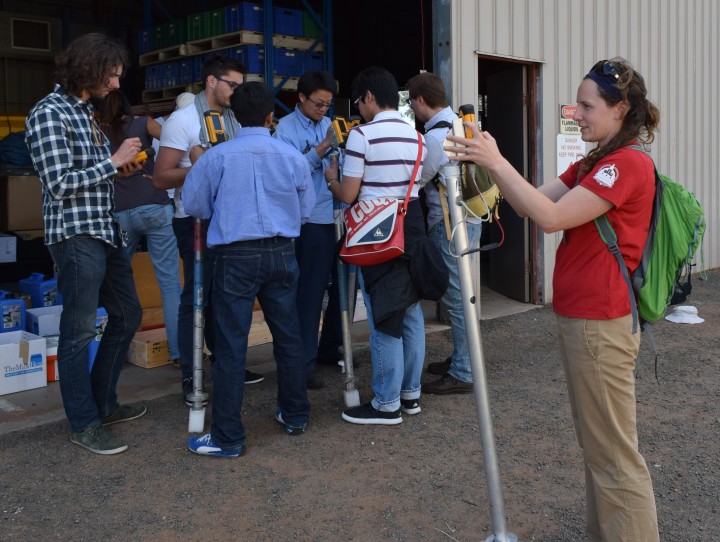
Amy NcNally (front) of NASA, Alex White (far left) of USDA and other members learn how to operate their field equipment. Photo by Lynn McKee, USDA.
The field teams also measure the land’s vegetation coverage and surface roughness. Vegetation is important to factor in, as it influences the radar and radiometer signals observed by SMAP. For instance, denser vegetation tends to block signals from the soil surface and can appear as a warm to the SMAP radiometer. This would tend to produce lower (or drier) retrieved soil moisture measurements if the presence of vegetation was not taken into account.
The field campaign is a large effort involving several parties. The SMAPEx-4 team includes scientists from Australia, The Netherlands, Germany, France and the United States, including from NASA and the U.S. Department of Agriculture (USDA). The campaign receives vital support from Yanco Agriculture Institute in Yanco, Australia in providing facilities, storage, heavy ovens and scales— items that would be difficult and costly to import. Walker, a member of the SMAP Science Definition Team, and his colleagues have been planning these campaigns for years with the first one starting in 2010. The last SMAPEx campaign in the series is scheduled in the Yanco region in September 2015.
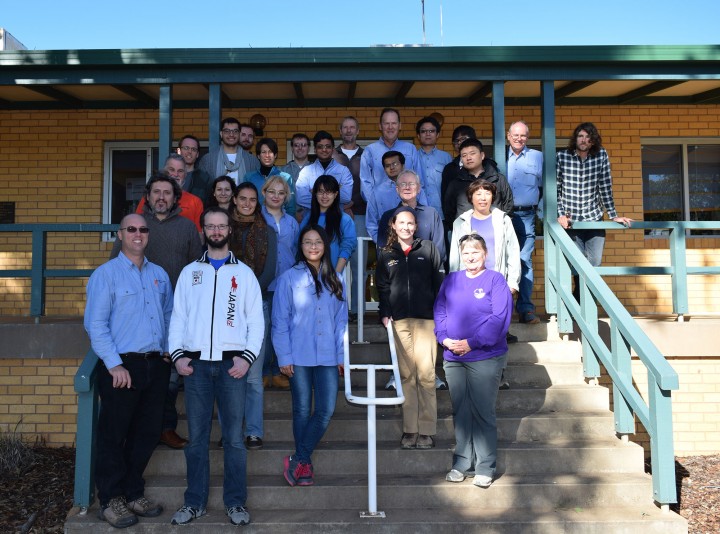
Participants from day 1 of the SMAPEx-4 field experiment: Wasin Chaivaranont, Paul Daniel, Shuvashis Dey, Ying Gao, Anouk Gevaert, Stefania Grimaldi, Muhsiul Hassan, Tom Jackson, Jon Johanson, François Jonard, Seokhyeon Kim, Fuqin Li, Yoann Malbéteau, Ian Marang, Alan Marks, Lynn McKee, Amy McNally, Grey Nearing, Philipp Pohlig, Luigi Renzullo, Chris Rüdiger, Sabah Sabaghy, Vivien Stefan, Jeff Walker, Alex White, Frank Winston, Xiaoling Wu and Nan Ye. Photo by Lynn McKee, USDA.
“Field experiments are one of the most demanding parts of validation in terms of human and fiscal resources. Therefore, they must be well designed and focused on specific objectives,” said Tom Jackson, SMAP Science Team calibration/validation lead and research hydrologist at the USDA.
To read blogs from the scientists participating in the field campaign, visit: smapex4.blogspot.com.au
For more information about the SMAPEx campaigns, visit: http://www.smapex.monash.edu.au/
For more information about SMAP, visit: http://www.nasa.gov/smap

Science team leader Dara Entekhabi discusses the science and engineering of NASA’s Soil Moisture Active Passive (SMAP) mission with the audience of a NASA Social held on January 28, 2015, at Vandenberg Air Force Base in California. Credit: NASA
Dara Entekhabi has been waiting 15 years for this moment—the launch of NASA’s Soil Moisture Active Passive (SMAP) satellite from Vandenberg Air Force Base in California. Even a snowstorm wasn’t going to stop him: He flew out of Boston just before a major storm dumped over 30 inches of snow on his home.
The satellite, which launched early in the morning of January 31, could aid in studying storms like that in the future. “Next year, if the East Coast sees another major Nor’easter snowstorm, forecasters will be able to predict the flood potential with greater accuracy,” said Entekhabi, lead scientist for SMAP at the Massachusetts Institute of Technology, Cambridge.
That’s because SMAP can measure how much water the ground can absorb. If the ground is frozen, the soil will not be able to absorb much water from snowmelt. Some of the worst floods occur when it rains on snow. “Its like you suddenly tip a water bucket,” he said.
Since 1999, Entekhabi has advocated for improving weather forecasts with dedicated satellite measurements of soil moisture. Previous investments in higher resolution satellite measurements led to improvements to weather forecast models. But there are other fronts to explore to improve forecasts’ accuracy further.
SMAP’s global look at soil moisture is one of the leading contenders, Entekhabi said. When scientists ran test forecasts using historical conditions, the computer models that integrated realistic surface soil moisture information produced a more accurate forecast. From this result, researchers realized an investment in better soil moisture measurements would provide significant improvements in weather forecasting.
With this knowledge, Entekhabi began the campaign of building advocacy among the science community for a dedicated soil moisture satellite mission. The SMAP mission—a collaboration between the Jet Propulsion Laboratory, NASA Goddard, and science team members from various institutions—has had ups and downs along the road to launch.
“It’s been a long haul,” Entekhabi says. “But I live this every day and I can’t imagine doing anything else.”
Two hours before SMAP’s early morning launch Saturday, Vanessa Escobar was on NASA TV, explaining a new effort to link the soil-moisture-measuring satellite with the people who will put it to use.
It’s called an ‘Early Adopter’ program – and it lets interested companies and agencies, from John Deere to the National Oceanographic and Atmospheric Association, take simulated SMAP data and develop the tools and computer programs to interpret it. With these tools and programs in hand, SMAP’s 45 Early Adopters will be ready to grab the satellite’s data as soon as it’s processed to help improve flood warning systems, forecast crop yields, better predict droughts, understand dust storms and more.
“It’s fantastic science, and through the early adopters the science is getting to the users,” said Escobar, an applications scientist at NASA’s Goddard Space Flight Center.
SMAP is the first NASA mission with an Early Adopter program. The mission’s science team has been driven to find ways in which the soil moisture data could be used to benefit people and communities, she said.
And so from an early point, Escobar and her colleagues reached out to people and groups who could use information about the soil’s water content. They started with some of the more obvious groups – agriculture researchers, weather forecasters – SMAP’s “close friends,” she noted. But as word of the program spread, others became interested as well: The public health scientist in the American Southwest concerned with respiratory impacts of dust storms, for example, or scientists interested in mapping sea ice with the satellite’s capability of determining whether a surface is frozen.
With their early access to simulated data sets and time to develop the tools to use them, those adopters are ready.
In the next couple months, after SMAP completes its check-out phase, “the job changes, it goes from simulated data to real data,” she said. “We keep working with the early adopters, we keep communicating with them, and instead of talking about the methods to use the SMAP data, we’ll talk about the impacts, and the societal benefits.”
California road trips cry out for a game I like to call “Guess What’s Growing by the Side of the Road.” The rules are simple – glance at the green leaves sprouting from the ground and guess whether they’re carrots or kale – and you can discover fascinating facts (artichokes are thistles!). This week, I’ve introduced a colleague to the game as we drove back and forth between our hotel and Vandenberg Air Force Base in California, past vineyards and rows of green plants in dark soil.
We’re here for the launch of the Soil Moisture Active Passive satellite, NASA’s latest mission to look back at our home planet. SMAP is designed to measure water content with unprecedented accuracy – and after talking with scientists and listening to briefings all week, I can’t think about the mystery roadside crops without wondering about water.
Soil’s water content is a key element in Earth’s ecosystem, scientists involved with the mission said this week. While agricultural fields now produce substantially more crops per acre than they did 50 years ago, agriculture is still very vulnerable to ’shocks’ like droughts, said Wade Crow, a research physical scientist with the USDA and SMAP science team member. An agricultural drought was one of the triggers for the 2008 food crisis when global food prices shot up, causing humanitarian crises, he said.
And measurements of soil moisture – the kind of information SMAP will gather – are the most direct and earliest indicator of agricultural drought.
“If you detect that directly, you are in a position to mitigate the effects. With better monitoring you can better respond so you can have less humanitarian and economic impact,” Crow said.
Soil moisture measurements will also be plugged into the weather models that help meteorologists forecast the rain that falls on those crops and other surfaces. Soil has an ’inherent memory’ when it comes to moisture, said Randy Koster, SMAP science team member and hydrologist at NASA’s Goddard Space Flight Center.
If it’s rainy in mid-June and the soil is wetter than usual, for example, it will probably also be wetter than usual in July, he said. That could impact how much water evaporates into the atmosphere to fall back as rainfall, as well as air temperature. Rainfall on wet soil is also more likely to run off, compared to rainfall that’s soaked up by parched soil, leading to better stream flow predictions.
“SMAP’s going to be providing unprecedented amounts of data on soil moisture, and utilized in these kinds of ways, we have the potential for better forecasts,” Koster said.